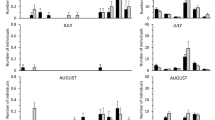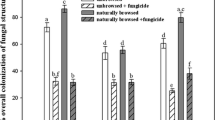Abstract.
Herbivores have diverse impacts on their host plants, potentially altering survival, growth, fecundity, and other aspects of plant performance. Especially for longer-lived plant species, the effects of a single herbivore species can vary markedly throughout the life of the host plant. In addition, the effects of herbivory during any given life history stage of a host plant may also vary considerably with different types of herbivores. To investigate the effects of herbivory by black-tailed deer (Odocoileus hemionus columbianus) and snails (Helminthoglypta arrosa and Helix aspersa) on a nitrogen-fixing shrub, Lupinus chamissonis, we established three exclosure experiments in a sand dune system on the coast of northern California. These experiments documented that deer browsing significantly reduced the volume and growth rate of lupines in the seedling and juvenile life stages. Since plant volume was strongly correlated with aboveground dry biomass for lupines, such herbivore-induced reductions in volume should translate into losses of aboveground biomass. Deer browsing also significantly altered the likelihood of attack by and density of a leaf-galling cecidomyid fly (Dasineura lupinorum), suggesting that a vertebrate herbivore indirectly affected an invertebrate herbivore in this system. Although deer did not significantly affect the survival of lupine seedlings and juveniles, individuals protected from deer had consistently greater survival in the two separate experiments. Our results revealed that snails did not have a significant effect on the survival or growth of juvenile plants, despite being common on and around lupines. An exclosure experiment revealed that herbivory by deer significantly reduced the shoot lengths of mature shrubs, but led only to a minimal reduction in growth rates. In addition, we found that browsed shrubs had significantly greater inflorescence production, but also produced individual seeds with significantly reduced mass. Collectively, these data indicate that deer and snails have widely differing effects on their shared host plant; browsing by deer indirectly affects insect herbivores, and the impacts of deer change markedly with the life history stage of their host plant.
Similar content being viewed by others
Author information
Authors and Affiliations
Corresponding author
Additional information
Electronic Publication
Rights and permissions
About this article
Cite this article
Warner, P.J., Cushman, H.J. Influence of herbivores on a perennial plant: variation with life history stage and herbivore species. Oecologia 132, 77–85 (2002). https://doi.org/10.1007/s00442-002-0955-z
Received:
Accepted:
Published:
Issue Date:
DOI: https://doi.org/10.1007/s00442-002-0955-z




